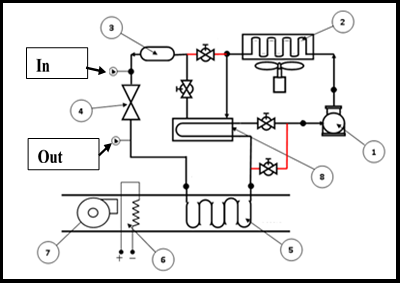Main Article Content
Abstract
Artikel ini menyajikan efek penambahan komposisi CO2 dalam sistem refrigerasi kompresi uap yang menggunakan refrigerant Musicool 134. Penelitian dilakukan untuk mengetahui karakteristik katup ekspansi (TEV) dengan variabel komposisi CO2 dari 0%, 1,5%, 3% dan 5% pada kecepatan putar kompresor 1000 dan 1500 rpm, penambahan beban pendinginan serta penggunaan IHE. Pengukuran dilakukan dengan mencatat nilai tekanan dan temperatur masuk serta keluar katup ekspansi. Hasil penelitian menunjukkan bahwa penambahan komposisi CO2 meningkatkan tekanan masuk dan menurunkan tekanan keluar katup ekspansi.
Keywords
Hidrokarbon, Musicool, karbon dioksida, air conditioning
Article Details
References
- A. S. Dalkilic and S. Wongwises, “A performance comparison of vapour-compression refrigeration system using various alternative refrigerants,” International Communications in Heat and Mass Transfer, vol. 37, no. 9, pp. 1340–1349, 2010.
- B. C. Purnomo and M. Setiyo, “Karakteristik sistem refrigerasi kompresi uap dengan refrigerant campuran musicool 134 - CO2,” Jurnal Teknologi, vol. 9, no. 2, 2017.
- X. H. Han, P. Li, Y. J. Xu, Y. J. Zhang, Q. Wang, and G. M. Chen, “Cycle performances of the mixture HFC-161 + HFC-134a as the substitution of HFC-134a in automotive air conditioning systems,” International Journal of Refrigeration, vol. 36, no. 3, pp. 913–920, 2013.
- R. K. Shah, “Automotive Air-Conditioning Systems – Historical Developments, The State of Technology and Future Trends,” in Proceedings of the 3rd BSME-ASME International Conference on Thermal Engineering, 2006, no. December, pp. 20–22.
- J. M. Calm, “The next generation of refrigerants – Historical review , considerations , and outlook 5 ´ ne ´ ration de frigorige ` nes – historique , analyse La prochaine ge et perspectives,” vol. 31, pp. 1123–1133, 2008.
- Z. Yang and X. Wu, “Retrofits and options for the alternatives to HCFC-22,” Energy, vol. 59, no. 2013, pp. 1–21, 2013.
- S. Wongwises and N. Chimres, “Experimental study of hydrocarbon mixtures to replace HFC-134a in a domestic refrigerator,” Energy Conversion and Management, vol. 46, pp. 85–100, 2005.
- M. K. Agrawal and A. G. Matani, “Evaluation of Vapour Compression Refrigeration System Using Different Refrigerants,” International Journal of Engineering and Innovative Technology, vol. 2, no. 9, pp. 86–92, 2013.
- M. Setiyo, S. Soeparman, N. Hamidi, S. Wahyudi, and M. Hanafi, “Numerical study on cooling effect potential from vaporizer device of LPG vehicle,” Journal of Engineering Science and Technology, vol. 12, no. 7, 2017.
- M. Setiyo, D. Syaka, B. Waluyo, N. Hamidi, B. Kiono, and J. Semarang, “Cooling effect potential from liquefied petroleum gas flow in the fuel line of vehicle,” International Journal of Automotive and Mechanical EngineeringOnline, vol. 14, no. 4, pp. 2229–8649, 2017.
- M. Setiyo, B. C. Purnomo, B. Waluyo, D. R. B. Syaka, and N. Hamidi, “Refrigeration effect and energy efficiency ratio (EER) calculation of 1/2 cycle refrigeration system on LPG-fueled vehicles,” 2018.
- M. Setiyo, S. Soeparman, S. Wahyudi, and N. Hamidi, “A simulation for predicting potential cooling effect on LPG-fuelled vehicles,” AIP Conference Proceedings, vol. 1717, 2016.
- M. Setiyo, Saifudin, B. C. Purnomo, B. Waluyo, and A. I. Ramadhan, “Temperature Distribution of R-134a Through Aluminum and PTFE Expansion Valve on Automotive Air Conditioning Applications,” ARPN Journal of Engineering and Applied Sciences, vol. 12, no. 4, pp. 1046–1051, 2017.
- K. Wang, M. Eisele, Y. Hwang, and R. Radermacher, “Review of secondary loop refrigeration systems,” International Journal of Refrigeration, vol. 33, no. 2, pp. 212–234, 2010.
- B. C. Purnomo and B. Waluyo, “Optimalisasi penggunaan refrigeran musicool untuk meningkatkan performa sistem refrigerasi kompresi uap dengan variabel katup ekspansi,” Semnastek Universitas Muhammadiyah Jakarta, no. November, pp. 1–7, 2015.
- S. Y. Liao, Q. Cheng, D. M. Jiang, and J. Gao, “Experimental study of flammability limits of natural gas-air mixture,” Journal of Hazardous Materials, vol. 119, no. 1–3, pp. 81–84, 2005.
- D. Colbourne and K. O. Suen, “Appraising the flammability hazards of hydrocarbon refrigerants using quantitative risk assessment model Part I: Modelling approach,” International Journal of Refrigeration, vol. 27, no. 7 SPEC. ISS., pp. 774–783, 2004.
- W. Yang, “A Simulation Study of CO2 Automotive Air Conditioing System,” University of Windsor, 2004.
- H. Liu, J. Chen, and Z. Chen, “Experimental investigation of a CO2 automotive air conditioner,” International Journal of Refrigeration, vol. 28, pp. 1293–1301, 2005.

